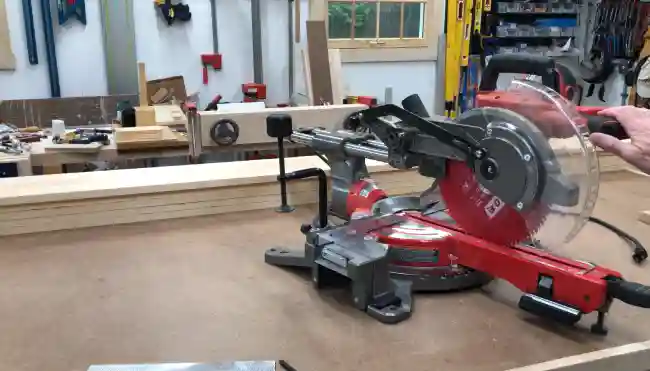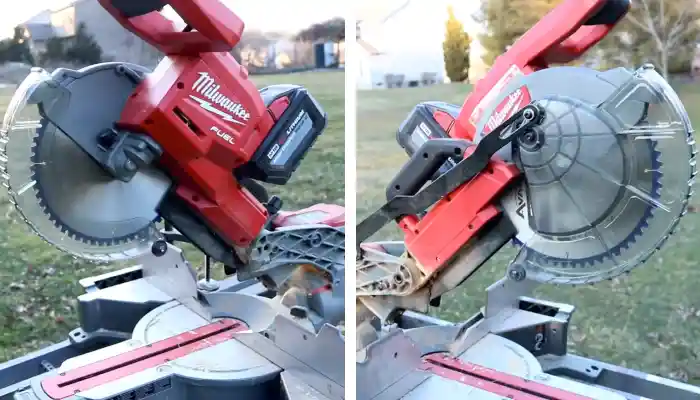10 vs 12 Sliding Miter Saw: 6 Key Differences
When selecting a sliding miter saw, one of the key decisions to make is choosing between a 10-inch and a 12-inch model. There are a few key differences between a 10-inch sliding miter saw and a 12-inch sliding miter saw.
The cutting capacity of a 12-inch saw is greater than that of a 10-inch saw, allowing for larger and thicker materials to be cut. There’s more power in a 12-inch saw compared to a 10-inch sliding miter saw, so it’s more efficient and has better cutting strength.
These two sliding miter saws also differ in other respects. Let’s explore the differences between the 10 vs 12 sliding miter saws, so you can decide which is right for you.
Differences Between 10 vs 12 Sliding Miter Saw

Sliding miter saws 10 and 12 have many differences. The 10 and 12 sliding miter saws differ in these categories.
- Cutting Capacity
- Motor Power
- Bevel and Miter Angle Range
- Weight and Portability
- Affordability
- Features and Enhancements
Let us examine the differences in more detail.
1. Cutting Capacity
One of the most significant distinctions between a 10-inch sliding miter saw and a 12-inch sliding miter saw is their cutting capacity.
The cross-cutting capacity of the 12-inch saw is greater, typically able to handle wider boards and longer cuts than the 10-inch saw, allowing for more extensive and efficient projects.
This makes the 12-inch saw ideal for professionals and those who frequently handle larger tasks, while the 10-inch saw is better suited to hobbyists and those with smaller cutting needs.
2. Motor Power
The motor power of a sliding miter saw is critical to its performance, and the 12-inch saw is typically equipped with a more powerful motor than the 10-inch saw.
Generally, a 12-inch sliding miter saw will have a motor power ranging from 15 amps to 20 amps, while a 10-inch sliding miter saw falls within the range of 10 amps to 15 amps.
Its added power makes it easy to cut through tougher materials, making it the preferred tool for professionals handling larger, more challenging projects. The 10-inch saw, in contrast, is more suited for hobbyists or those with smaller projects.
The increased motor power of the 12-inch sliding miter saw provides several advantages:
- Increased cutting capacity: The powerful motor enables the saw to cut thicker and denser materials, so you can do more.
- Enhanced efficiency: The higher amp rating ensures a consistent and reliable power supply, resulting in faster and more efficient cutting.
- Improved accuracy: The added power allows for smoother and more controlled cuts, reducing the risk of errors or inconsistencies.
3. Bevel and Miter Angle Range
Both the 10-inch and 12-inch sliding miter saws offer flexible miter angle adjustments, but the 12-inch saw typically has a wider range available.
The 12-inch saw offers a miter angle range of up to 60 degrees to the right and 50 degrees to the left, surpassing the 10-inch saw’s maximum angle of 57 degrees.
This extended range gives you more flexibility when working with different materials.
In addition, both saws feature dual-bevel capabilities, enabling you to make precise cuts at multiple angles without having to adjust the workpiece.
With the 12-inch sliding miter saw, you can confidently take on a wide range of projects, from simple trim work to intricate woodworking tasks.
| Saw Size | Miter Angle Range (Right) | Miter Angle Range (Left) |
| 10-inch | Up to 57 degrees | Up to 57 degrees |
| 12-inch | Up to 60 degrees | Up to 50 degrees |
4. Weight and Portability

The 10-inch saw is generally more portable and lighter weight, making it easier to move around and transport between job sites if necessary.
With limited workshop space or the need to move equipment frequently, this is an ideal solution.
On the other hand, the 12-inch saw is heavier, making it less suitable if you frequently move the saw between job sites.
But, the added weight and heft of the 12-inch saw can come in handy when tackling larger, more substantial projects. Ultimately, your choice between a 10-inch and 12-inch sliding miter saw depends on your individual needs and intended usage.
5. Affordability
The 10-inch sliding miter saw is typically a more budget-friendly option than the 12-inch saw, making it the perfect choice for beginner hobbyists or those on a tighter budget.
However, you may want to be willing to spend a bit more money, the 12-inch sliding miter saw may be the better choice.
6. Features and Enhancements
When comparing the 10-inch vs 12-inch sliding miter saws in terms of features and enhancements, the 12-inch saw generally offers more advanced features.
The addition of laser guides and dust collection systems are standard on 12-inch saws but may not be available on 10-inch saws.
However, the 10-inch saw is not far behind. It features an axial-glide system that allows you to move the saw back and forth smoothly. This system provides better control and precision when making cuts, making it a popular choice among professionals.
The 10-inch sliding miter saw also has dual-bevel capabilities, which can be found on the 12-inch saw as well. This feature enables users to make compound angled cuts in both directions without having to flip the workpiece.
Furthermore, the 12-inch saw incorporates advanced safety features and enhancements.
For instance, the LED cutline indicator with XPS technology provides improved visibility. A tall sliding fence can support crown molding up to 7-1/2 inches nested and base molding up to 6-3/4 inches vertically against the fence to improve safety.
These safety features make the 12-inch sliding miter saw a reliable tool to work with when cutting materials.
Comparison Table of the 10 vs 12 Sliding Miter Saw
| Categories | 10-inch Sliding Miter Saw | 12-inch Sliding Miter Saw |
| Cutting Capacity | Smaller width and length cuts | Larger width and length cuts |
| Motor Power | Lower amp rating | Higher amp rating |
| Bevel and Miter Angle Range | Up to 57 degrees (both sides) | Up to 60 degrees (right) and up to 50 degrees (left) |
| Weight and Portability | Lighter and more portable | Heavier and less portable |
| Affordability | Generally more budget-friendly | Typically more expensive |
What size board will a 12-inch sliding miter saw cut?

A 12-inch sliding miter saw is capable of cutting a wide range of board sizes. However, the maximum thickness it can handle is 4 inches.
It can effortlessly cut through 2 x 12 boards at 45 degrees and can even make bevel cuts up to 45 degrees. Additionally, it can make compound cuts, enabling it to accomplish complex cuts with unparalleled ease and precision.
So, to answer the question, a 12-inch sliding miter saw can cut boards up to 4 inches thick.
Can you put a 7.25-inch blade on a 10-inch miter saw?
While it may seem counterintuitive, it’s indeed possible to mount a 7.25-inch blade on a 10-inch miter saw. This expands its cutting capabilities and allows for more intricate and precise cuts.
The smaller blade size may raise questions about the compatibility and effectiveness of such a setup, but it can actually offer several advantages.
Firstly, by fitting a smaller blade on a 10-inch miter saw, you can achieve higher blade speeds. This is because the mass of the smaller blade is closer to the axis of rotation, allowing it to rotate faster. The increased speed can result in smoother and cleaner cuts, especially when working with delicate materials or intricate designs.
While the RPM of the smaller blade will be the same as that of a larger blade, the cutting edge will actually be moving slower. This reduced speed can be advantageous when working with more delicate or detailed cuts, providing greater control and precision and keeping away from miter saw accidents.
Making the Cut: Choose Your Ideal Miter Saw
So, choosing between a 10-inch and 12-inch sliding miter saw primarily depends on your woodworking needs. If you are a beginner hobbyist or have limited workspace, the 10-inch saw is a more affordable and portable option.
However, if you are a professional woodworker working on heavy-duty projects, the 12-inch saw’s powerful motor, wider cutting capacity, and greater bevel and miter angle range make it a more versatile and flexible option.
Additionally, the 12-inch saw comes equipped with more advanced safety features and enhancements, which provide improved visibility and support for more complex cuts.
With these differences in mind, it’s important to carefully weigh your options and choose the sliding miter saw that best fits your unique needs and budget.







